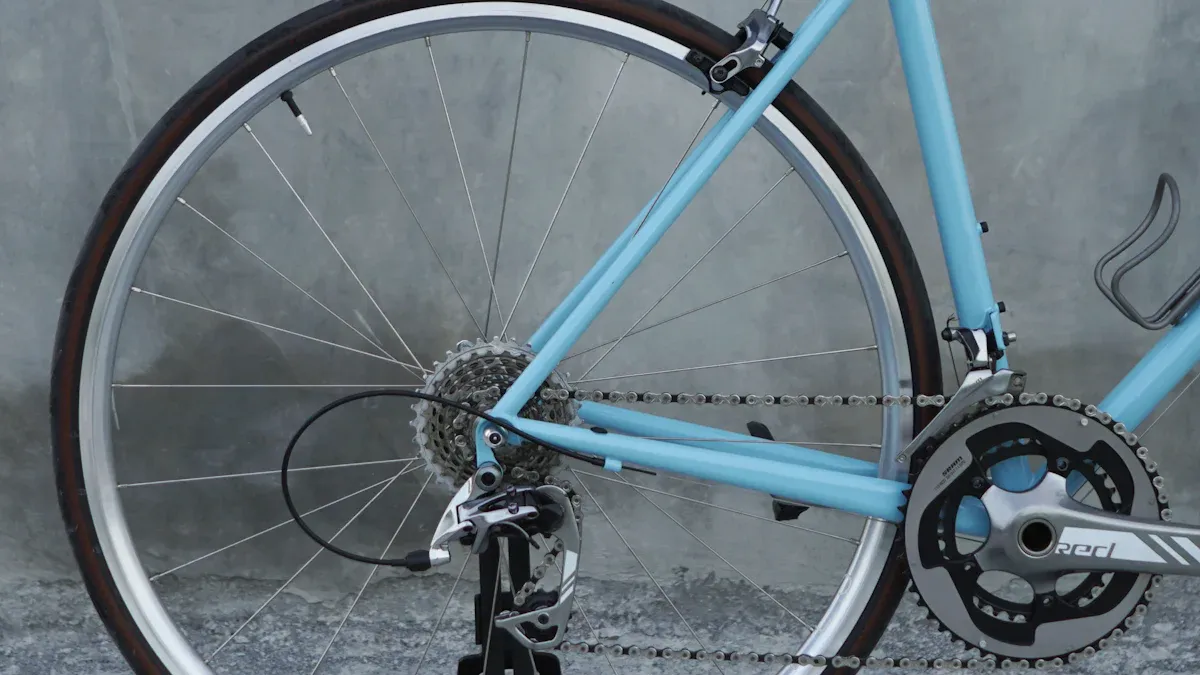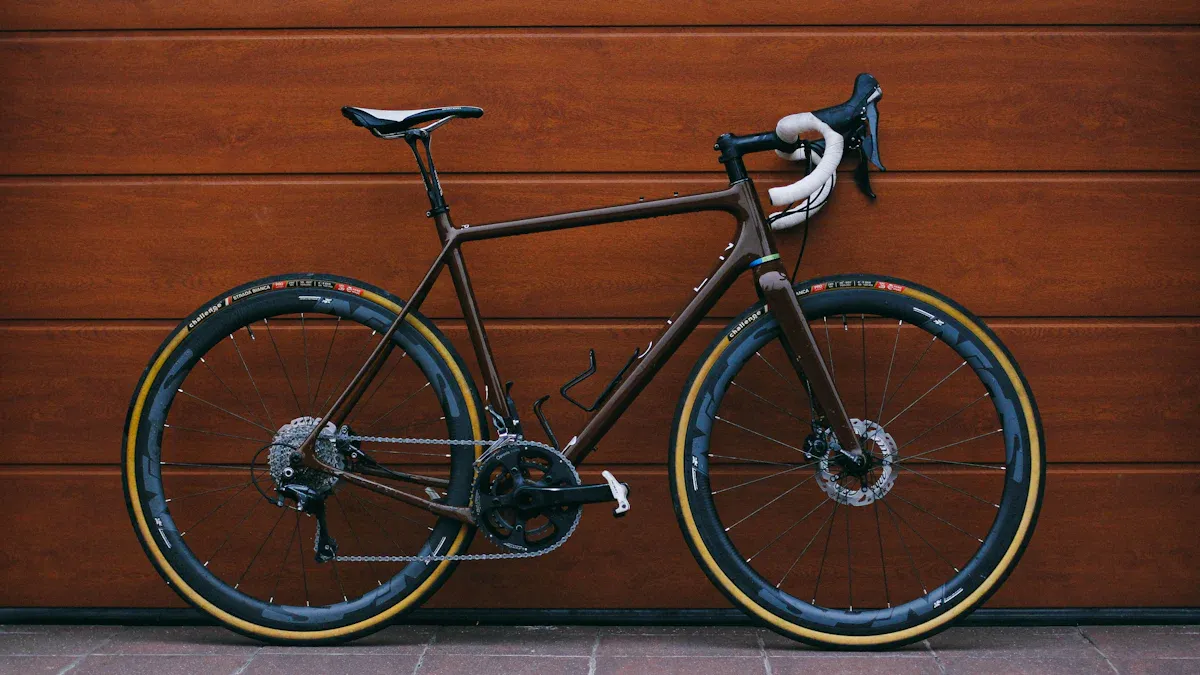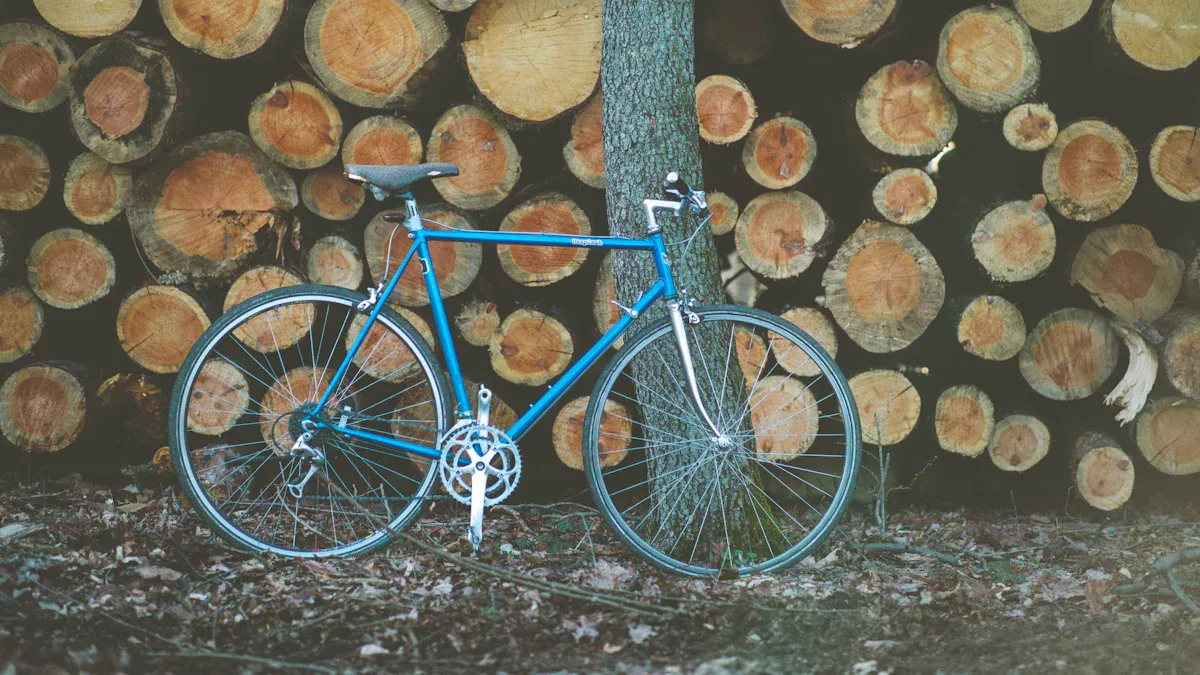
Understanding road bike frame shapes is important for a better ride, especially when considering a road bike frame comparison. The right frame can greatly affect how well you perform and how comfortable you feel. Picking the right shape helps you sit correctly, which makes you ride more efficiently.
Many new cyclists wrongly focus on materials instead of fit. They often ignore geometry charts that are key for choosing the right frame size and shape, which is crucial in any road bike frame comparison.
Getting the right bike fit is very important. It looks at your body size and how flexible you are. This careful attention can stop discomfort and injuries. It lets you enjoy cycling for many years.
Key Takeaways
Picking the right frame size is very important. It helps with comfort and how well you ride. Measure your inseam and height to find what fits best.
Know the differences between endurance and race shapes. Endurance bikes are comfy for long rides. Race bikes are made for speed.
The materials of the frame affect your ride. Carbon fiber is light and strong. Steel gives you more comfort. Pick based on how you ride.
Find a balance between stability and quickness in your bike choice. A stable bike is good for long rides. An agile bike is better for sharp turns.
Think about how you ride when choosing a bike. Road bikes are made for speed. Commuter bikes are made for comfort and everyday use.
Frame Size and Fit

Importance of Proper Fit
Picking the right frame size is very important in your road bike frame comparison. A good fit makes you more comfortable and helps you ride better. When your bike fits you well, you can ride longer without feeling pain. It also helps stop injuries that can happen from sitting wrong.
Many cyclists make mistakes when choosing frame sizes. Here are some things to avoid:
Picking bike size based on wheel size, not frame size.
Forgetting to check leg inseam or height when choosing frame size.
Thinking all bike sizes are the same, especially for adult bikes.
To get the best fit, look at the effective stack and reach measurements. These numbers help show your riding position. The stack measurement shows how high the handlebars are compared to the saddle. Reach measures how far the saddle is from the handlebars. A higher stack-to-reach ratio usually means a more comfortable ride. For example, a ratio over 1.5 often means a more relaxed position, which is great for long rides.
Measuring Techniques
Professional bike fitters use different ways to find the best frame size for each body type. They usually start by measuring things like inseam and height. Here’s how they do it:
Measure inseam and height to guess frame size.
Think about body proportions, like torso length compared to leg length.
Check geometry charts for compact frames to match top tube lengths.
For example, fitters multiply inseam measurements by 2/3 to find the right frame size. They also think about differences in torso and leg lengths. This helps you get a bike that fits your body shape.
Knowing standover height is also very important. This measurement shows how high the top tube is above the ground. You should be able to straddle the bike easily with a few inches of space. This keeps you safe and makes it easy to get on and off the bike.
Geometry Types
When you look at road bike frames, knowing about geometry types is very important. Different geometries fit different riding styles. They can change how comfortable you feel and how well you perform. We will look at two main types: endurance and race, plus aero and cyclocross geometries.
Endurance vs. Race
Endurance and race bike geometries have different goals. Each type changes your riding position and overall experience.
Feature | Race Road Bikes | |
|---|---|---|
Riding Position | More relaxed and upright | Lower and more aggressive |
Frame Geometry | Made for comfort and stability | Designed for speed and aerodynamics |
Wheelbase | Usually longer for stability | Shorter for quick movements |
More relaxed angle for comfort | Steeper angle for better aerodynamics | |
Tire Width | Wider tires (28mm to 32mm) for grip | Narrower tires to reduce drag |
Gearing System | Wide range with lower gears for climbing | Focused on higher gears for speed |
As you can see, endurance road bike geometry focuses on comfort. This design helps you ride longer without feeling pain. On the other hand, race bike geometry aims for speed and aerodynamics. This setup helps you go faster but may not be as comfy.
Aero and Cyclocross
Aero and cyclocross geometries are also very different. Knowing these differences can help you pick the right bike for you.
Aero Road Bikes:
Made for speed and stability on smooth roads.
Have a shorter wheelbase and special frame shapes to cut air resistance.
Encourage a more aggressive riding position to reduce drag.
Cyclocross Bikes:
Built for different terrains, needing a taller stack and shorter reach for quick moves.
Have a higher bottom bracket to clear obstacles.
Heavier and less aerodynamic, but good for off-road riding.
Both geometries change how the bike handles and how fast it goes. For example, the head tube angle, fork rake, and trail are key for steering. A higher bottom bracket and shorter chainstays make cyclocross bikes more agile.
Material Impact on Geometry

When you pick a road bike, the frame material is very important. It affects how the bike rides, how comfy it feels, and how well it works in different situations. Knowing about these materials can help you choose wisely.
Common Frame Materials
Here are some common materials used for road bike frames:
Aluminum: Light, cheap, and popular. It has a good mix of weight and stiffness.
Carbon Fiber: Loved for high-performance bikes because it is stiff and light. It lets makers design specific ride qualities.
Steel: A classic material that is very reliable and comfy for long rides. It is heavier but gives a smooth ride.
Titanium: Strong and durable, titanium is less common but offers a special mix of lightness and strength.
Material and Geometry Interaction
The way frame material and geometry work together really changes your riding experience. For example, carbon fiber lets makers design specific ride qualities. They can make some parts stiffer for power while keeping other parts flexible for comfort. This means you can have a fun ride without losing comfort.
Aluminum is a flexible choice for different riding styles. It balances weight and stiffness, making it good for racing and casual rides. Steel is heavier but great for comfort, especially on long trips. Titanium is light and strong, but its effect on geometry is not as strong as carbon fiber.
The geometry of your bike, like stack and reach measurements, works with the material to affect your riding position. A well-made frame can boost your comfort and performance, making your rides more fun.
Stability vs. Agility
When you pick a road bike, knowing the balance between stability and agility is very important. These two traits can change how you ride.
Stability in Design
Stability in bike design usually comes from the frame’s shape. A big part of this is the fork rake and offset. Fork rake is the angle of the fork compared to the head tube. Offset is how far the head tube is from where the front wheel touches the ground. Here’s how they change your ride:
If you increase fork offset, it reduces trail. This moves the contact patch forward. The bike feels more responsive but less stable.
If you decrease fork offset, it increases trail. This moves the contact patch back. It makes the bike more stable but can slow down steering.
A stable bike helps you ride with confidence, especially downhill or on bumpy paths. For example, a slacker head angle increases trail, which slows steering. This design can affect how you handle the bike.
Purpose | Characteristics | Trade-offs | |
|---|---|---|---|
Climbing Frame | Great for steep hills and getting power to the wheels | Light, stiff, made from high-quality carbon fiber, good stiffness-to-weight ratio | Loses some comfort and wind resistance for being lighter |
Comprehensive Frame | Good for different trails and riding styles | Balances lightness, stiffness, comfort, and speed | Might not be the best in any one area compared to special frames |
Aero Frame | Made to cut drag and go faster for racing | Designed for aerodynamics, often heavier than climbing frames | Not as good for climbing because of the extra weight and focus on speed |
Agility and Handling
Agility is also very important, especially for quick turns. It helps you go around tight corners and react fast to things in your way. Several things help a bike’s agility:
Material: Light materials like carbon fiber make the bike respond better. Titanium is strong and comfy.
Geometry: The head tube angle changes how you steer. A steeper angle can make it more agile, while shorter chainstays help with speed.
Integration Techniques: Good assembly lowers stress points, making strong connections between frame parts.
Professional cyclists often find a balance between stability and agility based on how they ride. If you like endurance riding, you might want a more stable frame. If you enjoy racing, you may choose a bike that focuses on agility. Knowing these differences helps you pick the right bike for you.
Riding Style Considerations
When you pick a road bike, your riding style is very important. It helps you find the right frame shape. Different riding types need different bike designs. Knowing these differences helps you choose wisely.
Road Cycling vs. Commuting
Road cycling and commuting have different needs. Here’s how their frame features compare:
Feature | Road Bike | Commuter Bike |
|---|---|---|
Riding Position | Leaning forward, aggressive | Sitting upright, relaxed, easy to see |
Tire Width | Narrow (25mm-32mm) for speed | Wider (35mm-50mm) for comfort and strength |
Gearing | Focused on performance, high gear ratios | Made for utility, wider range for hills |
Frame & Weight | Light materials (carbon, premium alloy) | Heavier, strong materials (steel, standard alloy) |
Accessory Mounts | Usually few or none | Many mounts for racks, fenders, and lights |
Primary Purpose | Speed, distance, fun, fitness | Practicality, reliability, all-weather use |
As you can see, road bikes are about speed and performance. Commuter bikes focus on comfort and usefulness. This design difference changes how you ride and your overall experience.
Long-Distance vs. Short-Distance Riding
The distance you ride also affects frame shape. Long-distance riders need a more relaxed design. This helps reduce tiredness and increases comfort. Here’s how the two types compare:
Type of Bike | Riding Position Characteristics | |
|---|---|---|
Racing Bike | – Sharp shape for better aerodynamics | – Lower and more forward position with a strong lean |
– Quick handling and fast response | – Strain on shoulders, arms, neck, and wrists | |
Endurance Bike | – More upright position, stable control | – Comfortable for long rides, less tiredness |
– Focuses on stable handling instead of quickness | – More wind resistance, slower speed |
For long rides, you want a bike that is comfy and stable. Short rides may let you have a more aggressive position, focusing on speed and quickness.
To sum up, knowing the main differences in road bike frame shapes can really improve your cycling fun. You learned why frame size and fit matter, the different types of geometry, and how materials affect how the bike works. You also found out about the balance between stability and agility, and how your riding style affects your bike choice.
When you think about comparing road bike frames, consider what you like and need for riding. Whether you care more about speed, comfort, or being flexible, the right frame can change your cycling experience.
Keep in mind, the best bike for you is one that matches your style and makes your ride more enjoyable!
FAQ
What is the best way to choose a road bike frame size?
To find the right frame size, measure your inseam and height. Use these numbers to check geometry charts. A bike fitter can help you get the best fit for your body.
How does frame material affect my ride?
Frame material changes weight, stiffness, and comfort. For example, carbon fiber is light and stiff. Steel is strong and comfy. Your choice should match your riding style and what you like.
Why is geometry important in road bike frame comparison?
Geometry affects how you sit, your comfort, and how well you ride. Different geometries fit different riding styles, like endurance or racing. Knowing geometry helps you pick a bike that fits your needs.
Can I use a racing bike for commuting?
Yes, you can use a racing bike for commuting. But racing bikes might not be as comfy or practical as commuter bikes. Think about your daily needs, like riding position and places for accessories.
How often should I get my bike fitted?
You should get your bike fitted if you feel discomfort or change how you ride. Regular fittings keep your bike comfy and efficient, making your rides better overall.
See Also
Key Factors to Consider When Evaluating Bike Frame Sizes
Essential Tips for Evaluating Carbon Race Bike Frames
Unique Features of Track Bike Frames Compared to Others
Distinguishing Characteristics of Fat and Mountain Bike Frames
Understanding the Differences Between Carbon, Aluminum, and Steel Frames
